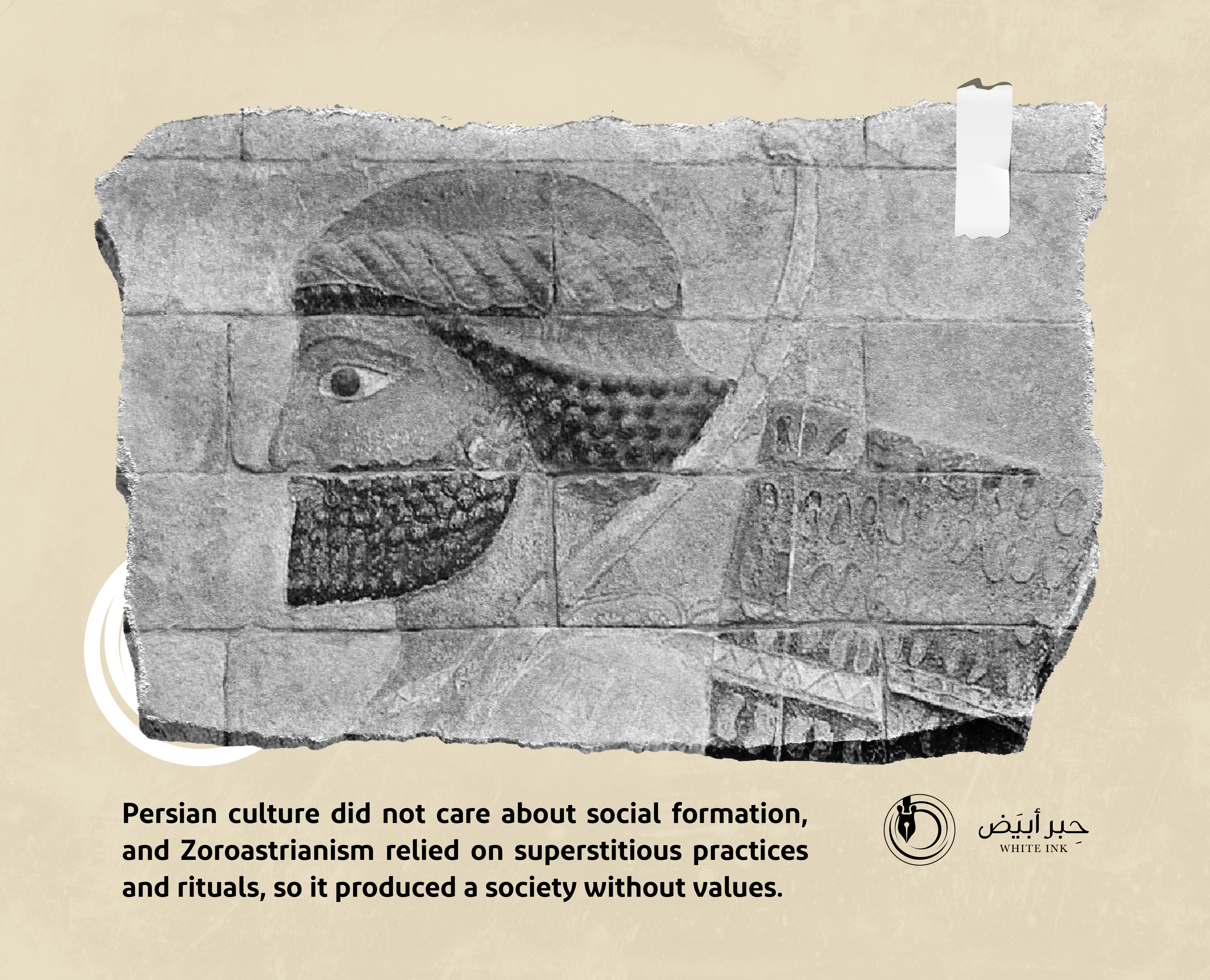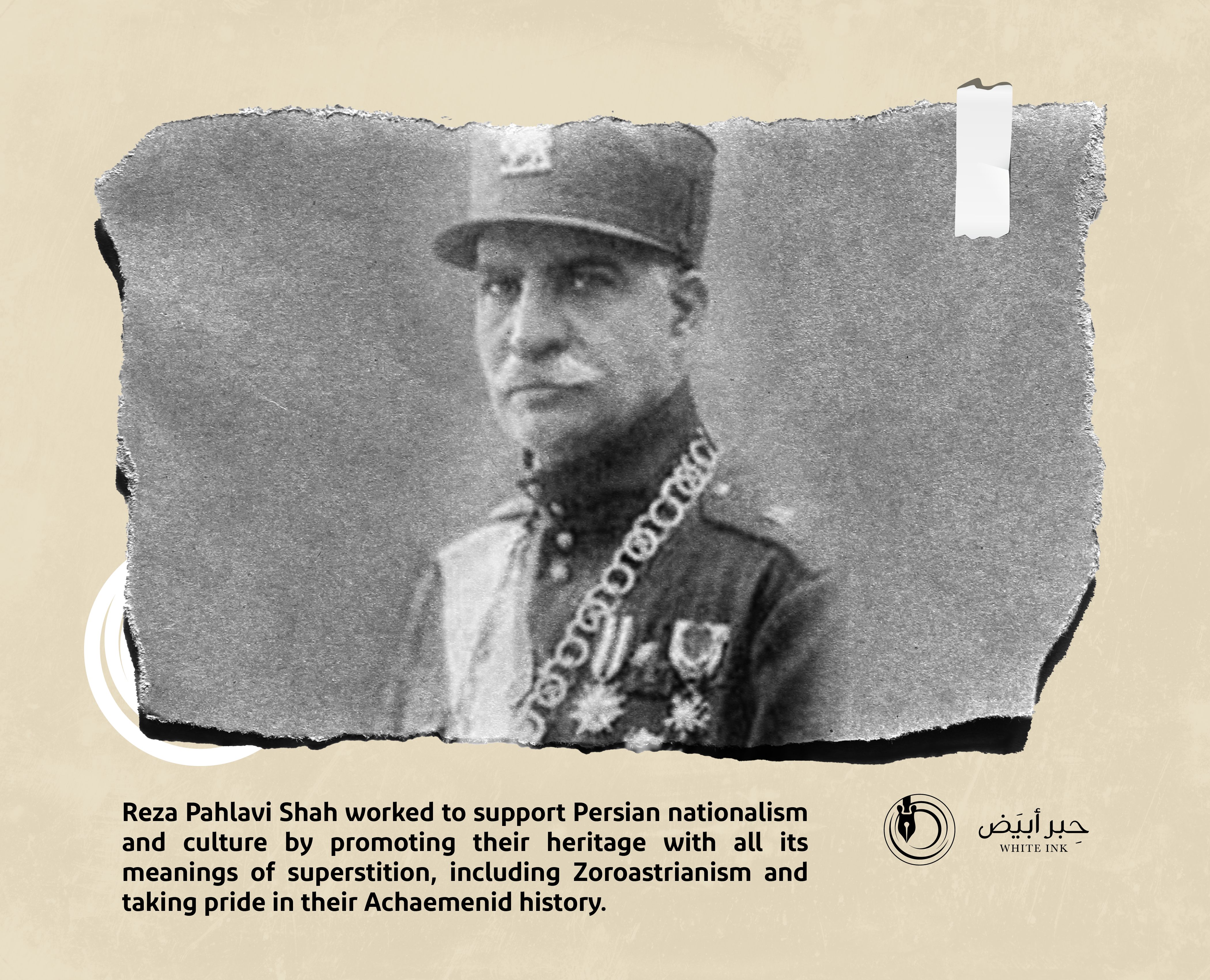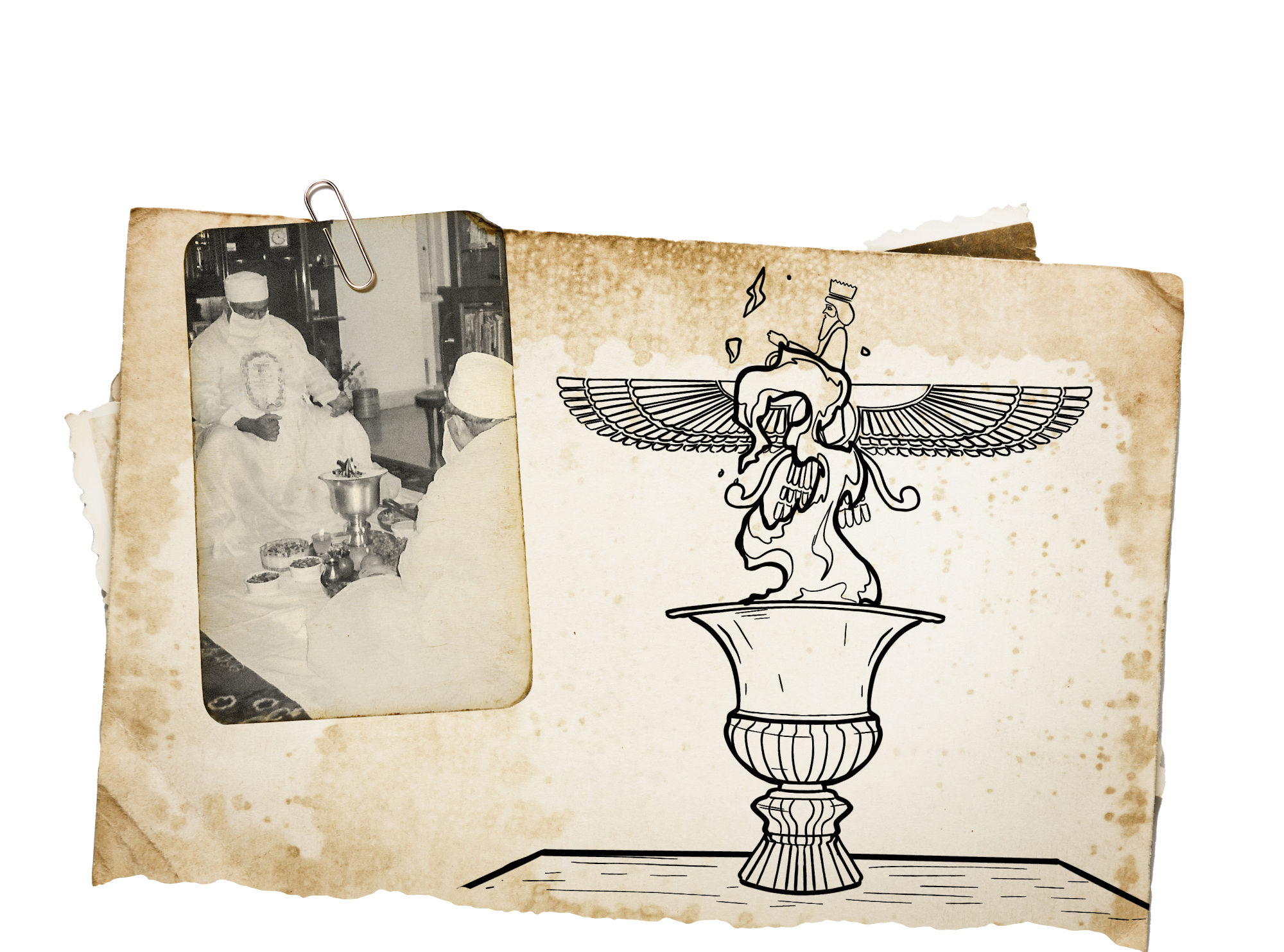
Zoroastrianism:
It was formed in the culture of the Persians and is still strongly present among them
Zoroaster is described in history books as a Persian clergyman and the original founder of Zoroastrianism, which spread in ancient Persia and survived until the first Islamic century, as it disappeared and vanished after Islam entered Persia. However, its influences and philosophy continued to occupy a large part of the culture of Persian society and affected their religious perceptions, especially on those who live in Iran and its surroundings, as Iran is the cradle of the ancient Zoroastrianism.
Zoroaster lived in areas between Azerbaijan, Kurdistan and present-day Iran, and his teachings and religion remained dominant over large areas in Persia and its space in Central Asia and its historical center of influence.
Understanding the origin of the founder of Zoroastrianism before its expansion and understanding his mentality also requires understanding its effects on Persia and other affected peoples, as it extended and became active in the history of the Persians until the Muslims’ victory over them in the Battle of Qadisiyah in (15 AH) (636 AD). With that victory, the legend of the ancient Persian Empire ended forever.
Despite the end of the Persian Empire, their teachings and culture remained in control of the mentality of many of them, especially Zoroastrianism, which symbolizes purity and serenity in the modern Iranian language. The word Zarathustra is made up of two words: (Zarath, ustra) meaning gold and beauty. That is why orientalists translated it as “the owner of the golden beauty”. Others interpreted it as meaning light and luminosity, and accordingly the full name was translated as “The one with golden light and luminosity” or (the divine aura).
As for Zoroaster, he is the son of Yorshab from Septiyama tribe in Azerbaijan, and his mother is Persian from present-day Iran. He was born in the sixth century BC, and the sources were unable to determine the exact date of his birth, but it is certain that he was born at the time of the spread of barbaric tribes in Iran. This was the time when idolatry spread and witches and charlatans dominated the minds of the simple people. Although Azerbaijan is the birthplace of Zoroaster, he moved to several regions and met some Israelites during his research trip. He got to know their religion and then returned to Azerbaijan, but he did not feel comfortable with Judaism.
The character of Zoroaster was not devoid of legends that gave him a lot of sanctity among his followers who attributed to him the book (Amenista) and its commentary (Zindavista). In the Amnesia, Zoroaster included his philosophy in his divisions of soul, body, and existence, and that the world rests on light and darkness, or good and evil. This is on the grounds that the world is based on the permanent conflict between two opposing powers, the good represented by the god of light (Ahuramazda) and the evil represented by the god of darkness (Ahriman). At the end of time, this struggle between light and darkness ends with the victory of the god of light. Therefore, Zoroastrianism is sometimes called Mazdaism. Muslims called it Magianism, which is the name of the religion of the worshipers of fire, and it is one of the religious rituals that was used by Zoroaster in worship.
Persian historical accounts describe Zoroaster as a brilliant and wise physician and philosopher who tried to access the secret of the universe through mental contemplation. Because his society was pagan and steeped in idolatry and witchcraft, he was persecuted at the outset of his call. The accounts say that his luck changed when the king’s horse fell ill, as Zoroaster was summoned to treat him, and after his success, the king rewarded him by spreading his religion. When a statesman married his daughter, he rewarded him by imposing his religion on the neighboring peoples.
Osama Adnan, author of the book (Zoroastrianism: Notes and Opinions), says: “Zoroaster divided the gods that he and his followers worshiped into three gods in various ranks, the highest among them was Ahuramazda, and the middle was Amesha spanda, and the third and least among them were a group of gods that he called the Yazidis. Zoroaster called his followers to pray to the various gods, but he also ordered them to make offerings to them of money, animals, and blood, and considered this an important part of proving slavery. This is very similar to offering sacrifices to saints and righteous people in some of the present-day Persia”.
There is an important question about the mixing of (Iranian Islam) with Zoroastrianism and the creation of new concepts in which the values of Islam were mixed with some Zoroastrian customs. It is true that Iranian Islam is dominant today among most of the Persian population, but many of the rituals that have been mixed with it are basically ancient Zoroastrian teachings or philosophy that have been mixed with Islam and have become as if they are Islamic rituals, and pure Islam is completely innocent of them.
The ancient Zoroastrian teachings were mixed with Persian Islam and imposed their thought, rituals and teachings on it until today.

In addition, the Lebanese researcher Jad Mhaidli says in his post: “There are two main groups of Zoroastrians, the Iranians and the Parsis. The Iranian Zoroastrians are those who remained in Iran following the Arab conquest that eventually made Islam the majority religion in the country. Although they preserved their religion for many centuries, only tens of thousands of them remain, and their religion is recognized by the current Iranian state, and they are represented by a Zoroastrian parliamentarian, especially after the Iranian revolution in 1979, which paved the way for the establishment of the current Islamic Republic. Therefore, there was a high wave of interest in ancient Persian history, and in Zoroastrianism in particular”. The researcher points out that Zoroastrianism is witnessing a revival among many Iranians who wish to express dissatisfaction with the current teachings in Iran. As for the Parsis, they migrated from Persia to India after the Islamic conquest and settled in there, where they could practice their rituals.
Since the Sassanid state adopted Zoroastrianism as its official religion before the Islamic conquest, its owners believed in the existence of two gods, one of them: (Ahuramazda), a god of good, and the other: (Ahriman), a god of evil, based on the philosopher Zoroaster’s division of the world into light and darkness. He called his followers to worship everything related to the light and the matter developed until the Persians eventually worshiped the fire.
Therefore, their religion became based on the worship of fire and the division of the world into one world of darkness and another of light. Zoroaster also claimed that the light of God is in everything that shines and blazes in the universe, and he commanded to turn to the direction of the sun and fire at the time of their worship because the light in his claim is a symbol of God. He commanded that the four elements should not be desecrated: fire, air, soil and water. After that, other people came and enacted various laws for the Zoroastrians, forbidding them to engage in things that require fire, so they limited their work to agriculture and trade. Starting from this glorification of fire and turning towards it in worship, people gradually began to worship it. The matter reached the point that they were clearly worshiping it in public and building temples for it, and every belief and religion other than the worship of fire became extinct.
Zoroastrianism reached a level of moral decadence that no other religion on earth had ever reached. Researcher Mustafa Al-Ansari says: “Since the fire did not reveal a law to those who worshiped it, did not send a messenger, did not interfere in their lives, and did not punish sinners and criminals, the religion of the Magians became a form of rituals and traditions that they performed in special places and at specific hours. As for outside the temples, or in their homes and the circles of their rule, they used to do what they liked or what served their interests. When everything became permissible for anyone, the foundation of morals became shaken. The relative taboos forbidden by the temperate natures of the people of the provinces became a matter of dispute”.
in “The Story of Civilization”, Will Durant talks about the Persians saying that the brother was marrying his sister, the father was marrying his daughter and the mother was marrying her son. The matter reached the point that the Persian King Yazdegerd II, who ruled in the late fifth century AD, married his daughter and then killed her, and King Bahram Jobin was married to his sister in the sixth century.


- Osama Adnan, Zoroastrianism: Notes and Opinions (Baghdad: Ashur Bani Pal, 2016).
- Saad Smar, The Gods Anhita: A Study of Historical Development (Iraq: Wasit University, 2018). Saad Smar, The Gods Anhita: A Study of Historical Development (Iraq: Wasit University, 2018).
- Abdullah Al-Abadani, History of Zoroastrianism, translated by: Abdul Sattar Kalhor (Duhok: Khani Press, 2011).
- Al-Shafi` Al-Mahi, Zoroaster and Zoroastrianism, Annals of Arts and Social Sciences, Kuwait University, Annal 11, Thesis 160 (2001).
- Muhammad Al-Saadi, Philosophical Dimensions in Zoroastrianism, Al-Zaytoonah University Journal, Issue 16, (2015).
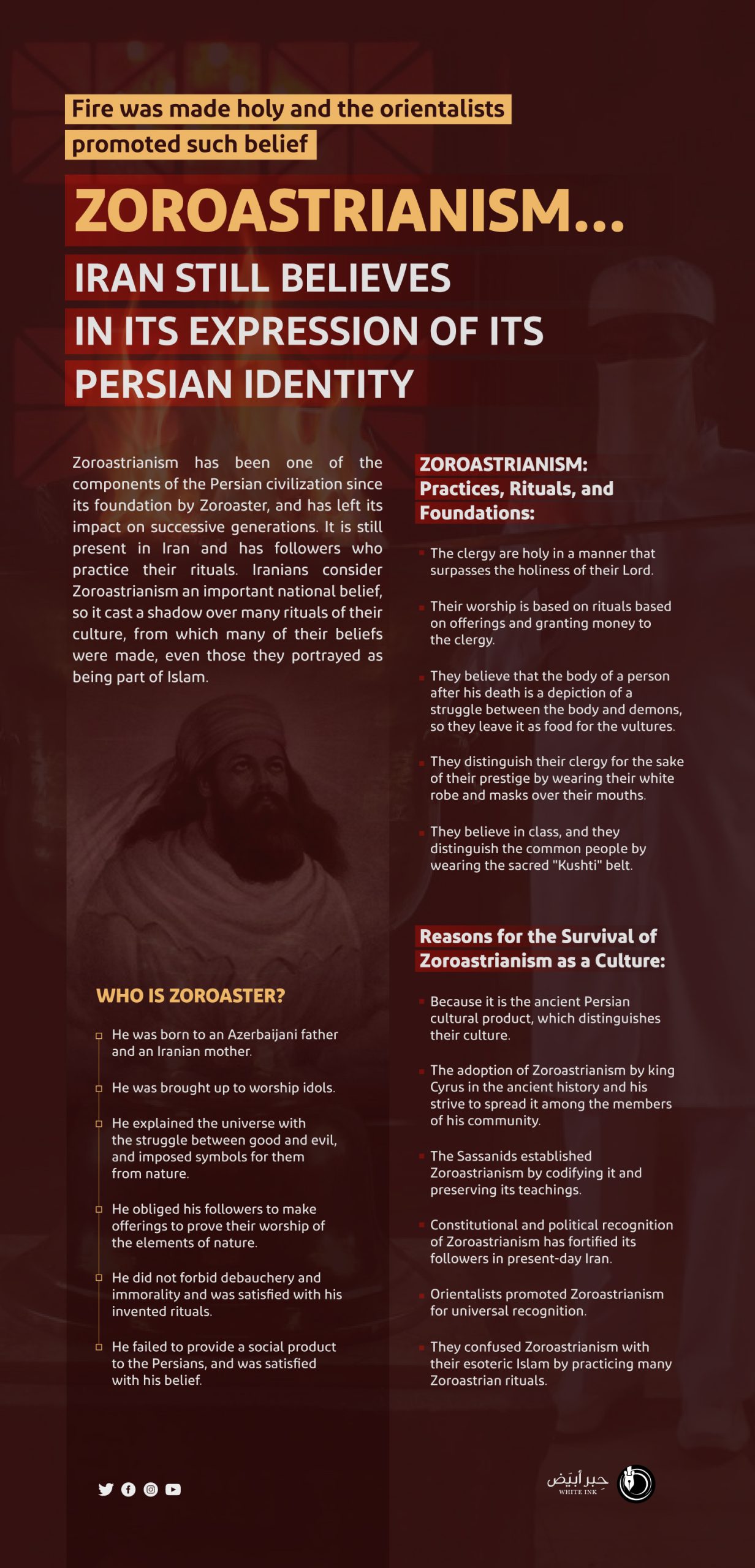
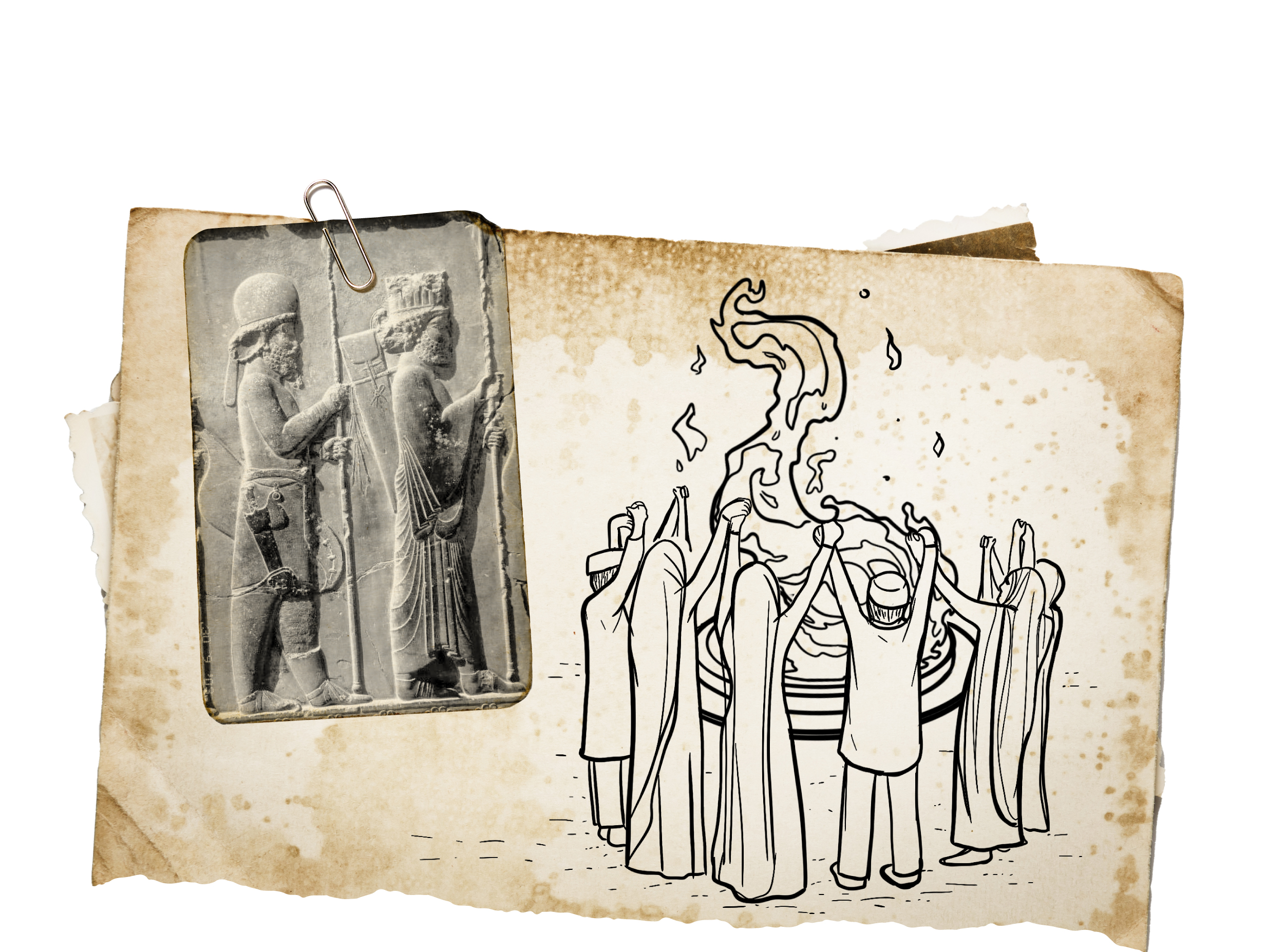
The Dakhma made the bodies of their dead food for vultures
The Zoroastrian beliefs of the Persians were influenced by an Indian culture that believed in myths
The beliefs, religions, and various rituals of ancient Iran were associated with deviant beliefs, most of which are linked to myths and legends, which are an influential part of the Persian mentality, starting from the early Persians’ worship of the sun, moon, stars and nature, and they are influenced by Indian beliefs.
The gods of India were similar to the gods of the Persians, as is the case with the gods Mitra, Mehr, Andra, Aruna, and other deities worshiped other than Allah. Zoroastrianism has appeared since the seventh and sixth centuries B.C., which is attributed to its founder Zoroaster, who Al-Shahristani (death: 548 A.H.-1153 A.D.) said about him in his famous book Al-Milal Wal-Nahl on Zoroastrianism: “Those are the companions of Zoroaster, son of Yorsheb, who appeared in the time of Kashtasb, son of King Lahraseb, and his father was from Azerbaijan and his mother was from Ray and her name was Degdawiya. They claimed that they had prophets and kings, the first of whom was Kiomrath, and he was the first to rule the earth, and his sanctuary was located in Istakhr, and came after him Oshinhak, son of Faruk, and he descended into the land of India, and he had a mission, then came after him Tmhudt… and then came after him prophets and kings, namely; Manujhar, who moved to Babylon and resided there. They also claimed that Moses, peace be upon him, appeared in his time until Kashtasp, son of Lahraseb became the ruler. In his time, the wise Zarathustra came, and they claimed that God Almighty, since the time of the Earliest Books and holy scripture, created a spiritual creation, and when three thousand years passed, he carried out his will in an image of sparkling light based on the image of man, surrounded by seventy honored angels, and created the sun, the moon, the planets, the earth, and the children of Adam without soul for three thousand years, then he placed the soul of Zarathustra in a tree that he built in the highest heavens, surrounded by seventy honored angels, and planted it at the top of a mountain in Azerbaijan. He has a classified book, which he said it was revealed to him, titled Zand-Avesta, in which the world was divided into two parts: Mina and Wauketi, meaning both the spiritual and the physical worlds. Zoroastrianism claims that it has many miracles.
It is understood from Shahrastani’s words that this religion was based on claims, legends and myths, especially that Zoroaster’s book contained irrational rituals, chants and rules. It only included peoples of Central Asia’s beliefs on the forces of nature and their divine symbolism.
Zoroastrianism was the official religion of the Achaemenid, Parthian and Sassanian empires, and was known as Mazdaism. Will Durant emphasizes in his book, The Story of Civilization, that the Medes were the ones who gave Persia their Aryan language and their thirty-six letters of the alphabet, and who taught them their moral laws, and guided them to depend during peace on agriculture, and at the end, they indoctrinate them with the religion of Zoroaster.
The Medes gave the Persians their writing system and developed their language, which they cherish today.

Thus, Zoroastrianism believed that the ancient ritual of fire was a symbol of light and the law of the cosmic god. The Persians, since before Islam, had been condemning Zoroastrianism (Mazdaism) that is based on the unity of existence, and on the union or separation between emanations from two gods, the god of light and the god of darkness. The doctrine of the Magian majority was based on the principle of light and darkness belonging to a higher being and from whom existence emerged, then Manichaeism came in agreement with Zoroastrianism in the origin of the doctorine.
As for the worship of Zoroastrians, at first, they did not have dedicated temples, but rather were isolated places in which they performed their religious rituals, then gradually appeared some rituals that did not seem to be approved by Zoroaster, such as the use of Hawuma, a kind of poison, in their rituals and false prayers, and the slaughter of bulls, to offer them to the god Mitra. Zoroaster integrated into his religion a range of ancient Persian deities, and divided his gods into two types: good gods and evil gods, and Ahura Mazda is on top of the good ones, and his cooperation with six gods expressing abstract meanings, such as sound thought, righteousness, divine ruling, piety, salvation and immortality.
Ahrman is on top of the evil ones, and the struggle between him and Mazda, which sums up the Zoroastrian philosophy of the universe. In general, the outward features of Zoroastrianism are taken from the worship of Hindus and Sikhs. Fire is sacred to the Zoroastrians and they use it in their rituals, and it symbolizes some pure substances, as well as water and earth. Their eagerness not to profane their worship ended with exaggerated means of purification.
Zoroastrians wear some symbolic religious clothing as part of their daily dress to remind them of their religion, including wearing the sacred belt (Kushti) in which seventy-two threads are tied, symbolizing the chapters of the book (Yasna), and the belt is tied several times a day as a metaphor for moral and religious resolve.
Also, among their symbols is the Sadari shirt, which symbolizes the religion itself, and the priests among them wear white robes, turbans and masks over their mouths while performing the rituals of the sacred fire, in order to avoid profanation with the same breath. One of them must submit to the ritual of purification before prayer and confess the sins committed by thought, word and deed.
The Zoroastrians also believe that death is the work of Satan, so the corpse is the dwelling of demons, and the greater the righteousness of the deceased, the greater the power of the demonic action, so they put the corpses in the “towers of silence” (dakhma) where eagles prey on them. Their ways are similar to the inhabitants of the Tibetan highland in making the bodies of their dead prey to vultures.


- Muhammad al-Shahristani, “Al-Milal Wal-Nahl”, edited by: Muhammad Sayyid Kilani (Beirut: Dar Al-Maarifa, 1982).
- Abdullah Al-Abadani, History of the Zoroastrian Religion, translated by: Abdul Sattar Kalhour (Dohuk: Mokhryani Foundation, 2011).
- Firas Al-Sawah, Encyclopedia of the History of Religions, translated by: Abdul Razzaq Al-Ali and others (Beijing: Genesis, 2016).
- Muhammad Ghorbal, Facilitated Arabic Encyclopedia (Cairo: Dar Al-Geel, 1995).
- Will Durant: Story of Civilization, translated by: Ibrahim Amin Al-Shawarbi (Cairo: Al-Khanji Library, 1947).

Iran mixed two historical beliefs:
Persian Zoroastrianism and Esoteric Shiism in the populism way
Persian religious patterns were based on Zoroastrianism as an important ancient religious expression, which spread in Persia as a result of some principles that intersect with the behavioral structure of the Persians. This is in addition to Zoroastrianism’s unique addressing of the phenomenon of the eternal conflict between good and evil, light and darkness, and defended the oneness of God and the free will of human beings according to its distorted, twisted concept, far from divine legislation.
Zoroastrianism has benefited from several factors in its survival and continuity; Perhaps the most important of them is the doctrinal identification of the founder of the first Persian state, Cyrus, with the principles of Zoroastrianism. As well as the continued circulation and inheritance of the principles of Zoroastrianism, through the codification of its principles by the Sassanid state, which compiled and codified the only copy of the “Abestaq” (Avesta), and then preserved some of the principles of Zoroastrianism in a book agreed upon by the Persians.
Because the Sassanid state adopted Zoroastrianism as the official religion of Iran, and it did not have an official religion until that time, this contributed to its survival and continuity, while the peoples affiliated with Iran were free to convert to the religion accepted by each of them. It seemed that this situation was temporary due to the circumstances of a historical stage in which it is difficult to impose Persian culture and religion on other peoples, but the situation changed after their domination, and the Persians became obsessed with spreading and imposing their culture, as similar to what Iran is doing now in our contemporary time by imposing its culture and will on other peoples, promoting its nationalism and Persian identity.
Religious behavior in Persian society resorted to a force majeure to promote its continuity; To impose an apparent acceptance by all sides, and they are both the two necessary conditions for the accumulation of any religious belief. The believers would then turn into the fiercest defenders. This fact made Zoroastrianism withstand, albeit relatively, in the face of cultural and religious change before Islam came to bring the Persians out of the darkness of their beliefs to the clear light of Islam. Zoroastrianism was kept on the margins of Persian beliefs in which the Iranians saw an expression of their ethnic identity which determine their racist expressions towards the rest of the ethnic and sectarian components from inside and outside.
In addition to the logical explanations that records the survival and continuity of the effects of the Zoroastrian culture among the Persians despite the weakness of its structures and evidence, one of the additional reasons for this unwavering behavior is due to the nature of the goal and message that Zoroastrianism defends and preaches to its followers. Here, we find that the Zoroastrian teachings preach and emphasize to strive in order to advance the nationalism of the Persians through their distorted beliefs and perceptions, including that the good Persians will join Ahura Mazda in the paradise they believe in, as for the people of evil, they will fall into a deep abyss of darkness, in which their food will be poisonous venom.
On the other hand, the writings of orientalists, for non-innocent considerations, contributed to the spread of the principles of Zoroastrianism and their continued dissemination. Orientalist writings about this Persian religion were active, especially in the eighteenth and nineteenth centuries. A researcher confirms this by saying: “Since then, Avesta studies and research have advanced regarding language and content in a quick manner, and many European scholars have published important texts and research on Zoroaster and Zoroastrianism, such as: “Thus Spoke Zarathustra” by German philosopher Friedrich Nietzsche (1844-1900) in the last quarter of the nineteenth century.
The Orientalists, for non-innocent considerations, contributed to the promotion of Zoroastrianism and the dissemination of its principles in many parts of the world.

Although Iran adopted the esoteric doctrine and considered it the official doctrine of the state, by politicizing the Shiite doctrine and employing it to serve the Safavid project of the state, the Persian ethnic belief continued to control the political expressions and ideological structure of the Persians. Perhaps the ethnic intersections with Zoroastrianism prompted Iranian politicians to pay attention to the need to value and promote this belief and increase its value as part of the Iranian civilizational component.
Therefore, Reza Pahlavi Shah realized the importance of integrating Zoroastrianism within the Iranian identity, and therefore he sought a lot to strengthen the feelings of national pride, which he achieved through the great attention he paid to the greatness of the former Iranian empires: the Achaemenid, the Parthian, and the Sasanian; In this way, the goals of the Shah coincided with the goals of Zoroastrianism.
In conclusion, we find that Persian Iran has two beliefs, the first and the most influential one is the ethno-national belief that supports Zoroastrian principles as a Persian component, and the second is Shiism as a strategic choice to impose Persian culture and achieve its aspirations to promote its dominance and impose its culture on other peoples. Therefore, we find that a lot of overlap occurred between the two Persian beliefs, Zoroastrianism and esoteric Persian Shi’ism.


- Jad Mohaidli, Get to Know Zoroastrianism…The Mysterious Iranian Religion, An-Nahar Lebanese newspaper, (2019).
- Hassan Pernia, The Ancient History of Iran…From the Beginning to the End of the Sassanid Era, translated by: Noureddine Abdel Moneim and Al Sibai Muhammad (Cairo: The National Center for Translation, 2013).
- Abdullah Al-Abadani, History of the Zoroastrian Religion, translated by: Abdul Sattar Kalhour (Dohuk: Mokhryani Foundation, 2011).
- Will Durant: The Story of Civilization, translated by: Ibrahim Amin Al-Shawarbi (Cairo: Al-Khanji Library, 1947).

